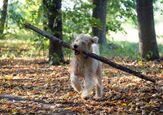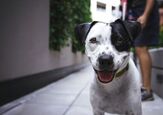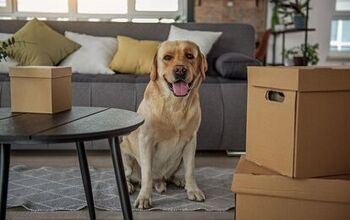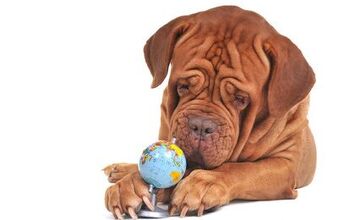Gardening Tips for Pet Parents

When spring returns, it’s the right time to get outside and start tending to your garden. But if you have pets who will be out there with you, it’s important to know that there are many hazards that can pose a risk to their health.
One of the top springtime safety tips is to ensure your garden is free of harmful chemicals, toxic plants, and other threats. Keep reading to learn more.
Keep Fleas Away Naturally
Taking steps to keep fleas out of your yard is important for everyone in your family. If you have fleas in your yard—and it can happen because of strays and wildlife who pass through and spend time in your outdoor space—you risk them getting on your pet.
Even if you have a strictly indoor kitty who doesn’t go outside on a leash or spend time in a catio, fleas could jump on you and make their way inside your home and onto your feline companion.
You can use flea preventatives made for dogs and cats, and there are various options, from natural solutions to flea collars, that you can look into as you decide what’s best for you and your pets. Consulting a veterinarian is wise, as some products contain strong ingredients that may cause side effects.
In addition to talking to your vet about the best flea preventatives and treatments for your pets, you can also treat your yard to reduce the risk of exposing them to fleas. Unfortunately, many pesticides may be dangerous to pets and people.
The good news is there are products like Flea Destroyer, which is natural because it uses microscopic, harmless nematodes to prevent fleas from infesting your yard. You prepare it with water that you then spray throughout your yard, allowing the 10 million beneficial nematodes to make their way into the soil, where they’ll feast on flea larvae before they can grow into adults. Just be sure to follow the directions closely for the best results.
Also, you can keep fleas out by maintaining a clean and organized yard, so mow the lawn regularly and remove debris, fallen branches, and leaves where fleas can hide.
Choose Pet-Safe Fertilizers, Mulch, and Compost
When it comes to growing your garden, use fertilizers carefully, as they can be harmful if ingested. Even if pets end up licking the residue of fertilizer off their fur after being exposed to it in your yard, they could experience side effects. Compost, too, should be kept out of reach of pets because they might eat it and get sick as a result.
If you like to use mulch around your yard, be sure you choose the right type to keep your pets safe—cocoa mulch, in particular, should be avoided because it’s toxic to dogs and cats. Beware, too, that mulch could be a choking hazard, so you might avoid the use of mulch altogether for peace of mind.
For fertilizers, consider using worm castings like Earth Science Earthworm Castings. This can be used for all types of plants, including flowers, trees, shrubs, and fruit. It can be used for plants in the ground or in pots, and it helps them grow better naturally with 100% vermicompost and no fillers or peat. It also helps improve soil structure to retain nutrients and water better. And the best part is this type of fertilizer is non-toxic to pets.
Fill Your Garden with Pet-Friendly Plants
In the same way that you need to be careful about indoor plants when you have dogs and cats, you also need to carefully consider the ones you’ll have in your garden. Sometimes, even exposure to a plant’s pollen can be detrimental—as in the case of lilies and cats, for example.
You can use this ASPCA resource to look up plants and find out if they’re toxic or non-toxic. Here are some of the plants to keep away from your pets:
- Lilies (toxic to cats)
- Oleander (toxic to dogs and cats)
- Azalea (toxic to dogs and cats)
- Sago palm (toxic to dogs and cats)
- Foxglove (toxic to dogs and cats)
- Rhododendron (toxic to dogs and cats)
- Iris (toxic to dogs and cats)
Bulbs can also be dangerous if they’re ingested. Daffodils are popular in the spring, but they’re toxic to dogs and cats, and the bulbs are the most toxic part. Another popular springtime flower, the tulip, is toxic to dogs and cats, with the bulb being the most toxic.
Create Spaces Specifically for Your Pet
The best way to protect your pet in your outdoor space is by using products that are safe and plants that are non-toxic. But you can go a step further by creating areas of your yard that are specifically for your pet, where they won’t be exposed to anything that’s potentially toxic.
By keeping your dog or cat in safe areas of your yard, they can have fun and get some exercise without you worrying about their well-being. Plus, this can ensure your landscaping won’t be ruined by a dog who likes to dig. Get creative, whether you want a spot for your cat’s outdoor enclosure for scent enrichment or you want your dog to have room to run.
If you want to share your yard with your pets, there’s a lot to keep in mind when designing your outdoor space. But once you know what to do, you’ll be able to rest easy knowing you have a welcoming garden that you can enjoy with your furry friend.
Join the PetGuide community. Get the latest pet news and product recommendations by subscribing to our newsletter here.

Lisa Selvaggio is a freelance writer and editor, and our resident cats-pert, with certifications in pet nutrition and pet first aid. She enjoys producing content that helps people understand animals better so they can give their pets a safe and happy home.
More by Lisa Selvaggio

























